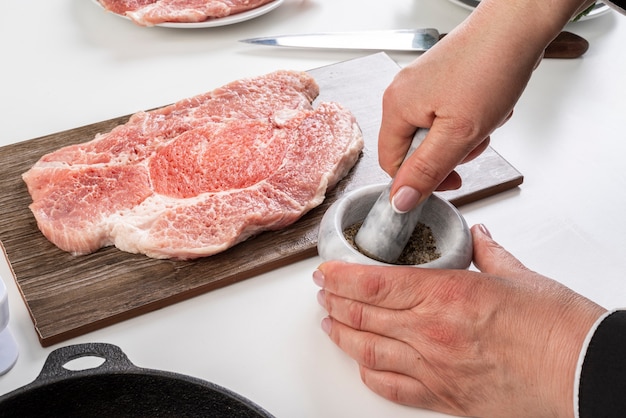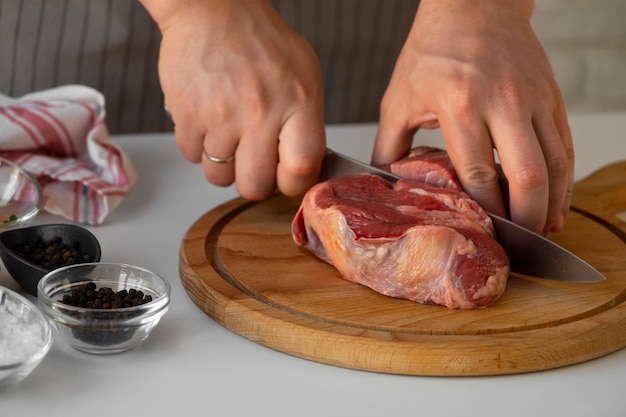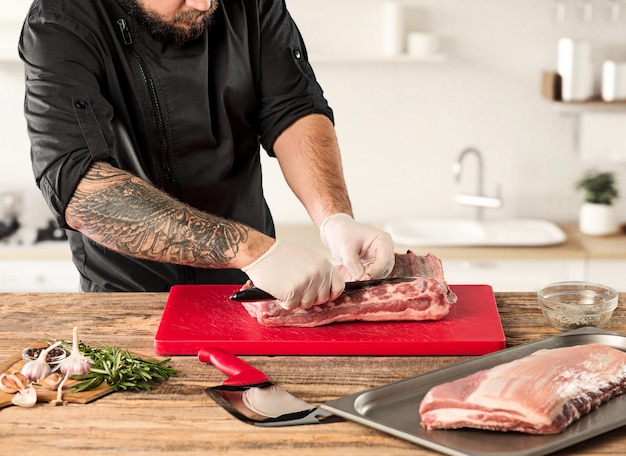Let's be honest, there's nothing quite like a perfectly cooked steak. That beautiful sear on the outside, the tender and juicy inside...it's culinary nirvana. But achieving medium-well perfection can be a bit of a challenge. For years, I wrestled with the question: how long do I cook it for? I've had my share of dry, overcooked disasters, but through trial and error, I've finally cracked the code. And now, I'm ready to share my wisdom, and maybe, just maybe, help you avoid those steak disasters too.
We're talking about medium-well, the sweet spot where the steak is cooked through, but still retains a hint of pinkness in the center. It's the perfect balance of flavor and texture. It's a happy medium that, when done right, satisfies both your taste buds and your desire for a well-cooked piece of meat.
Part 1: Understanding the Basics

Before we dive into cooking times, let's talk about the basics. The truth is, there's no one-size-fits-all answer. It's all about understanding the key factors that affect how your steak cooks.
1.1. The Cut Matters
You wouldn't expect a marathon runner to train the same way as a sprinter, would you? Well, the same principle applies to steak. Different cuts of steak have different muscle structures, and that affects how they cook. A tender cut like filet mignon, with its fine muscle fibers, will cook much faster and more evenly than a tougher cut like a chuck steak, which has coarser fibers.
1.2. Thickness and Weight
Think of it this way: a thin slice of bread toasts much faster than a thick loaf. The same logic applies to steak. A thicker steak, with its larger volume, will naturally take longer to reach the desired internal temperature.
1.3. Cooking Method
The method you choose, whether it's a blazing hot grill, a sizzling pan, or a steady oven, will also influence the cooking time. Each method creates different levels of heat transfer, which affects how quickly your steak cooks.
1.4. Desired Doneness
And, of course, we can't forget the ultimate goal: your desired doneness. Medium-well, as we've already established, strikes a happy medium, with a cooked center and a subtle pinkness. It's the Goldilocks of steak doneness, not too rare, not too well-done, but just right.
Part 2: The Golden Rule

Now, you've probably heard the term "resting" thrown around in the culinary world. For steak, resting is not just a suggestion, it's a necessity. It's like a secret weapon that unlocks a whole new level of deliciousness.
2.1. Resting: Why It Matters
When a steak is cooking, those flavorful juices get trapped within the muscle fibers. As it cools down, the fibers relax and the juices have more room to redistribute throughout the meat. It's like a miniature water park for flavors, allowing them to flow freely and create an explosion of juiciness in your mouth.
2.2. How Long to Rest?
Give your steak a little time to unwind, about 5-10 minutes before slicing. It might seem like an eternity, but it's worth it for a more tender, juicy, and flavorful steak. Imagine it like a spa day for your steak. It's all about relaxation and rejuvenation.
Part 3: The Ultimate steak cooking guide (Part 1)

Now that we've covered the basics, let's get our hands dirty. This guide will take you through the steps of achieving medium-well perfection for your steak.
3.1. Choose Your Steak
First things first, choose the right cut for the job. As we discussed, tender cuts like filet mignon or ribeye are ideal for medium-well. These cuts cook evenly and retain their juiciness, resulting in a truly satisfying dining experience.
3.2. Seasoning
A little salt and pepper goes a long way. Don't be afraid to season generously, as this helps create a delicious crust and enhances the natural flavor of the steak. You can also experiment with other seasonings like garlic powder, onion powder, or a sprinkle of smoked paprika for an extra flavor kick.
3.3. Preheat Your Grill or Pan
A hot grill or pan is key to achieving that beautiful sear on the outside. It creates a flavorful crust that helps seal in the juices and prevents the steak from sticking.
3.4. The Sear
Place your steak on the preheated grill or pan and sear for about 2-3 minutes per side. Focus on one side at a time, giving it a nice, even browning. Think of it as a warm embrace for your steak.
3.5. Reduce Heat
After searing, reduce the heat to medium-low. You want to maintain a steady, even heat to cook the steak through without overcooking it. It's about creating a cozy and controlled environment for your steak to relax and cook through.
Part 4: Cooking Times for Medium-Well
Here's where we get into the heart of the matter: timing. Remember, cooking times can vary based on the thickness, weight, and cut of your steak, as well as the cooking method you're using.
4.1. Grill
For a 1-inch thick steak on a grill, aim for 6-8 minutes per side for medium-well. Be sure to use a meat thermometer to check the internal temperature to ensure your steak is cooked through. You want to strike that perfect balance between a juicy center and a satisfyingly cooked exterior.
4.2. Pan-Fry
When pan-frying, cook a 1-inch thick steak for about 5-7 minutes per side to achieve medium-well. Remember to use a meat thermometer to gauge the doneness, and adjust the cooking time based on your steak's thickness.
4.3. Oven
For oven roasting, a 1-inch thick steak should take about 10-12 minutes for medium-well. Place the steak on a baking sheet and roast in a preheated oven. Again, using a meat thermometer is crucial to ensure the steak is cooked to the desired level of doneness.
Part 5: The Ultimate Steak Cooking Guide (Part 2)
We're almost at the finish line! Let's complete our steak cooking journey.
5.1. Internal Temperature
Now, let's talk about the secret weapon of every seasoned steak cook: the trusty meat thermometer. It's like a magic wand that reveals the hidden truth about your steak's internal temperature. For medium-well, aim for an internal temperature of 145°F (63°C).
5.2. Resting Time
After cooking, let the steak rest for at least 5-10 minutes before slicing. This is crucial for allowing the juices to redistribute and ensure a truly juicy and tender steak. Think of it as a well-deserved break for your steak after a long day of cooking.
5.3. Slicing
Now it's time to unveil the masterpiece you've created. Slice the steak against the grain for maximum tenderness. This technique separates the muscle fibers, making it easier to chew and allowing the flavors to burst in your mouth.
5.4. Enjoy!
Congratulations! You've successfully cooked a delicious medium-well steak. Take a moment to appreciate your culinary achievement, savor each bite, and enjoy the fruits of your labor. It's a symphony of flavors and textures, a testament to your dedication to steak perfection.
Part 6: Top Tips for Steak Perfection
Here are some extra tips to help you elevate your steak game even further.
6.1. Don't Overcrowd
When grilling or pan-frying, avoid cramming too many steaks into one space. This can lead to uneven cooking and a less-than-perfect steak. Give each steak room to breathe and cook evenly, like a peaceful garden where each flower receives ample sunlight.
6.2. Use a Meat Thermometer
We can't emphasize this enough. A meat thermometer is your best friend when it comes to steak. It takes the guesswork out of cooking and helps you avoid overcooking your steak. It's a reliable guide that ensures your steak reaches the perfect internal temperature, no matter how thick or thin it is.
6.3. Don't Overcook
It's a common culinary dilemma: overcooking vs. undercooking. Always err on the side of undercooking. You can always cook it a little longer, but bringing a dry, overcooked steak back to life is nearly impossible. Remember, it's better to have a slightly pink center than a tough, chewy steak.
6.4. Don't Press the Steak
Resist the urge to press down on the steak while it's cooking. This forces the juices out, resulting in a dry and tough steak. Let the steak cook undisturbed, allowing the natural heat to work its magic. Think of it like a delicate dance, where you gently guide the steak towards its culinary destiny.
Part 7: Common Mistakes and How to Avoid Them
We've all been there, those moments of culinary despair when our steak doesn't turn out quite as we hoped. But don't worry, with a little knowledge and foresight, we can avoid those mistakes and achieve steak perfection.
7.1. Overcooking
The most common steak-cooking sin is overcooking. This results in a tough, dry, and unappetizing steak. It's like a culinary tragedy, a beautiful steak transformed into a leathery disappointment. To avoid this fate, remember to use a meat thermometer and cook your steak to the desired doneness.
7.2. Not Resting the Steak
Remember, resting is not a luxury, it's a necessity for a truly juicy and tender steak. Without this crucial step, the juices will escape, leaving you with a dry and unappetizing steak. Think of resting as a key element in the steak-cooking symphony, a pause that adds depth and richness to the final result.
7.3. Not Using a Meat Thermometer
A meat thermometer is the ultimate culinary hero, saving your steak from the perils of overcooking and undercooking. It's a small investment that yields big rewards, ensuring your steak is cooked to the perfect internal temperature every time. So, invest in a meat thermometer, and let it become your trusted guide in the world of steak cooking.
Part 8: FAQs
Now, let's address some frequently asked questions about steak cooking.
8.1. Can I Cook a Steak on High Heat the Whole Time?
While it's tempting to crank up the heat and cook your steak in a flash, it's not recommended. High heat can lead to uneven cooking and a burned exterior, while the inside might remain undercooked. Start with high heat for searing, then reduce the heat to medium-low for even cooking.
8.2. What Happens If I Overcook My Steak?
Overcooked steak is a culinary tragedy. It loses its moisture and tenderness, becoming tough and dry. The muscle fibers contract and tighten, making it an unpleasant experience. To avoid overcooking, use a meat thermometer and cook your steak to the desired doneness.
8.3. What's the Best Way to Reheat a Steak?
Reheating a steak can be tricky. The best method is to reheat it in a low oven, around 250°F (121°C). This gentle heat helps reheat the steak evenly without drying it out. It's like a warm bath for your steak, restoring its moisture and tenderness.
8.4. Is It OK to Use a Microwaving a Steak?
Microwaving a steak is a culinary crime. It results in an unevenly cooked, rubbery, and unappetizing steak. Think of it as a culinary horror story. Avoid the microwave for reheating steak, and opt for a more gentle method like the oven.
8.5. What's the Best Way to Cut a Steak?
The best way to cut a steak is against the grain. This means slicing perpendicular to the muscle fibers, making the steak easier to chew and digest. It's like a culinary ballet, where you gently separate the muscle fibers, revealing the full flavor and texture of the steak.
Part 9: steak doneness chart
Here's a handy chart to guide you through the world of steak doneness.
| Doneness | Internal Temperature (°F) | Internal Temperature (°C) |
|---|---|---|
| Rare | 125-130 | 52-54 |
| Medium-Rare | 130-135 | 54-57 |
| Medium | 135-140 | 57-60 |
| Medium-Well | 140-145 | 60-63 |
| Well-Done | 145 | 63 |
Part 10: Conclusion
So there you have it, a comprehensive guide to achieving medium-well perfection for your steak. It's a journey of understanding, a process of mastering the art of steak cooking. With practice and patience, you'll be wowing your friends and family with your culinary prowess.
Remember, steak cooking is a dance of heat, time, and technique. Embrace the process, experiment with different cuts and methods, and most importantly, enjoy the journey. Happy grilling, frying, or roasting!
Everyone is watching

Perfect Rice Every Time: The Ultimate Guide to Cooking Rice
Cooking TipsAs a self-proclaimed foodie, I've always been a bit obsessed with rice. It's the foundation of countless cuisi...

Prime Rib Roast Cooking Time Chart: Per Pound Guide
Cooking TipsPrime rib roast. Just the name conjures images of lavish dinners, crackling fires, and hearty laughter. It’s ...

The Ultimate Guide to Cooking Asparagus: Tips, Techniques, and Recipes
Cooking TipsAsparagus. The mere mention of this spring delicacy conjures up images of vibrant green spears, crisp and burs...

Ultimate Guide to Cooking the Perfect Thanksgiving Turkey
Cooking TipsThanksgiving. Just the word conjures up images of overflowing tables laden with delicious food, the scent of r...

How Long to Bake Potatoes in the Oven (Perfect Every Time)
Cooking TipsBaked potatoes are a staple in my kitchen. They're incredibly versatile, delicious, and surprisingly easy to m...
